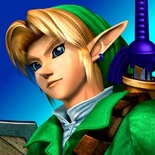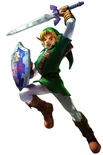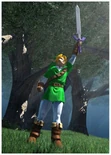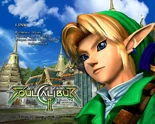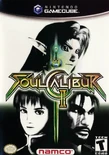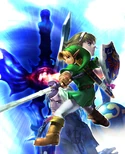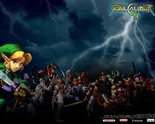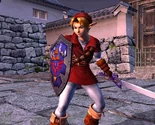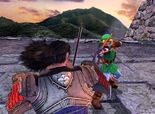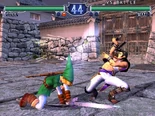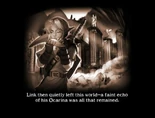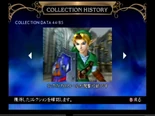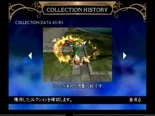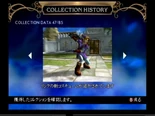- "His courage and faith are his greatest weapons."
- — Narrator (Soulcalibur II)
Hailing from The Legend of Zelda series, Link (リンク Rinku?) is a guest character exclusively for the Nintendo GameCube version of Soulcalibur II. There are multiple heroes that rose to the call of destiny in Hyrule's history, each bearing the name Link and garbed in traditional attire. This particular Link is the one from The Legend of Zelda: Ocarina of Time, though some of his weaponry and secondary costumes references most games predating or shortly after the Nintendo 64 title's release within the Nintendo franchise (resulting in a Link that some fans consider either timeline-confused or self-contained).
What lies in his soul is Courage.
Appearance[]
Link's appearance is one of transcendence, not appearing as one entity but an entire line of heroes. The Link in Soulcalibur II is the legendary Hero of Time from Ocarina of Time. As such, he appears as a young man with blonde hair with bangs framing his face and blue eyes. His ears are long and pointed similar to an elf, a common trait among Hylians. As per tradition, he wears a long, green floppy hat and a matching tunic along with white stocks and brown boots. Though a minute detail, he also wears a pair of blue earrings.
Possessing the most alternate costumes out of any other character in the Soul series within one game, Link's alternate costumes are palette swaps of his original outfit based on appearances from other Zelda games:
- His 2P outfit (red) is taken from both the Goron Tunic of Ocarina of Time and the Red Ring effect of the original NES game, where it protects him from superheated locations and few hazards in the former while in the latter it is the best defense upgrade.
- His first unlockable outfit (blue) is taken from both the Blue Mail of A Link to the Past and the Zora Tunic of Ocarina of Time, which in the SNES game was the first defense upgrade and in the N64 title gave him the ability to breathe underwater.
- His second unlockable outfit (light violet) is taken from the Blue Ring's effect from the original NES Zelda game which was the first defense upgrade prior to the Red Ring.
In-game profile[]
Once upon a time, Hyrule's tranquillity was shattered by the arrival of several disasters. The calamities brought dark, ominous clouds which shut out the sun. Surprisingly, it came to light that a magician was to blame for the disasters.
Just as the people were about to lose all hope, the sun miraculously returned. Link, who was summoned by Zelda to find the cause of the disasters, successfully defeated the magician. The people of Hyrule rejoiced in the belief that eternal peace would rule.
Unfortunately, this was not to be.
It became clear that the magician responsible for the disasters was in fact controlled by an evil sword called Soul Edge, which existed in another world.
Furthermore, the fragments of Soul Edge were gathering together in this other world.
Knowing that the resurrection of the evil blade must be prevented at all costs, Link chose to travel to the other world and destroy Soul Edge.
Link gathered his trusted Master Sword, Hylian Shield, and Ocarina, and set off on a secret journey.
Ending[]
Link came to this world in order to defeat the evil which threatened Hyrule.
After a long journey, Link finally succeeded in sealing away the terrible evil.
In doing so, he not only saved his homeland from peril, but also maintained the tranquility of this world.
Link then quietly left this world--a faint echo of his Ocarina was all that remained.
Fighting style[]
Unlike most characters, Link is a self-taught fighter with only experience in battle as his lessons, but ultimately is an expert. While typically favoring the use of his sword and shield, he is never seen without an assortment of other weapons such as bombs and a bow with arrows, making him a versatile fighter capable of tackling any situation.
Link's moveset references his official source material as well as the Super Smash Bros. series, employing special attacks like the Downward Thrust, Spin Attack, and the Hyper Dash Attack, and can do swift kicks. While armed with a sword and shield like Sophitia and Cassandra, his blade's longer reach lets him play a safer poke game. Though lacking in a combo game, he is unique in that he's one of the first characters in the series with projectiles, using his various weapons as stances to attack from a distance. His Bow allows him to aim and shoot arrows either straight in front of him or aim them to attack downed/ducking opponents or to intercept aerial attacks and juggle them. His Boomerang can hit opponents on return even if they dodge the initial throw, and his Bombs hit low, with a delayed hold making them unblockable after being thrown. Some of his attacks can also transition into these weapon stances as finishers or allow him to adjust his approach by switching it up.
Weapons[]
- Master Sword and Hylian Shield
- Razor Sword
- Armos Series
- Megaton Hammer
- Cane of Byrna
- Mirror Shield
- Magic Sword and Magic Shield
- Biggoron's Sword
- Soul Edge (Complete)
- Great Fairy's Sword
- Bug-Catching Net
Trivia[]
- In a poll at IGN.com, Link was awarded first place in the "Soulcalibur Top Bonus Characters" list, and there are many fans who wish to see him return in future Soulcalibur games.
- According to Namco, Link is the most difficult character to design in Soulcalibur II, as everything about the character, including his attacks, must be strictly approved by Nintendo.[source?]
- Link's scabbard, which he keeps on his back, only appears when using the Master Sword and Hylian Shield, as the other weapons have it seemingly vanish, including the Mirror Shield.
- Link coincidentally shares the same Japanese voice actor as Nightmare, Siegfried and Yoshimitsu: Nobuyuki Hiyama. This game is also the last of said actor providing the voice of Adult Link from the Legend of Zelda series.
- Charade and Inferno can't use Link's weapons, as well as any of the other guest characters' weapons. Story-wise, this is excusable, as Link and the other guest characters are from another world outside of their reach.
- Link is the first elf-like character to appear in the Soul series, the second being Scheherazade in Soulcalibur IV.
- Hylians, however, are actually human.
- Like the other guest characters, Heihachi and Spawn, his Destined Battle is with Raphael.
- Link is the first non-Namco video game character to appear in the Soul series as well as having the distinction of being the first 1st-party character to appear in the franchise. The second is the Apprentice from Star Wars: The Force Unleashed, and the third is Kratos from the God of War franchise (who was the second 1st-party character in the series)
- Although Link's story is not canon to either the Legend of Zelda or Soulcalibur series in any way, his adventure seems to be referencing not only Ocarina of Time, but A Link to the Past and Majora's Mask as well. Though the game features the Hero of Time, the prologue says that he battled a wizard to save Hyrule, which could possibly be Agahnim. He pulled the Master Sword from its pedestal in the Lost Woods seen in the opening cutscene, as opposed to the Temple of Time - another reference to the Super NES game. And after saving Hyrule, he quietly sets off on a second journey in the Soul universe to finish his job of restoring peace by destroying Soul Edge and then left the world once more to return back to his homeland, a reference to Majora's Mask of himself after saving Termina from Majora's Mask. It must be noted, though, that alongside using many weapons from those games and the earlier NES titles, Link in Soulcalibur II is most likely self-contained.
- Like Assassin and Berserker, Link only displays grunt and yell vocalizations and therefore doesn't talk. However, he actually has the ability to speak, but merely chooses not to, as he famously follows the role of a "silent protagonist"; In the Legend of Zelda series, Link usually only says "Yes" or "No" to respond to certain questions in the games. In the 3D games, you can see his speech responses in the options the player can choose as well, confirming Link isn't necessarily mute.
- When Link wins a battle (except in Weapon Master mode), the original victory music is replaced by the jingle music that plays when the player finds an important item, from the Zelda games. Likewise, when playing as Link, on some instances the Legend of Zelda theme replaces the stage's normal music.
- While Link's respective non-green tunics in the Zelda series, especially the early 2D games, were used as defensive upgrades and sometimes contain bonus protection against certain hazards (such as the red outfit reducing the damaging effect of lava in the case of Ocarina of Time), they serve no such purpose in Soulcalibur II.
- Link's Hyper Dash Attack in Soulcalibur II, contrast to its "Hyper" name, is a significantly toned down version of his high-speed trademark attack in some Zelda games such as A Link to the Past or Link's Awakening, as Link is never wearing the Pegasus Boots, and he simply and momentarily runs toward his opponent with both his hands on his sword rather than one, similar to a spear weapon. However, like in its source material, he can crash into walls, causing Link to fall down, briefly stunned.
- Despite only appearing on the GameCube version of the game and is not canonical, Link's fighting style has stayed within the Soul series to a degree. In the PlayStation 2 sequel Soulcalibur III, the "Sword and Shield" discipline contains some of Link's moves, but any of the attacks which are direct references to the Zelda games, such as the Spin Attack and the Dash Attack, are removed.
- Up until Patroklos was announced for Soulcalibur V, Link was, for nine years, the only male human character to specifically wield a sword and shield in the series.
- Link is the only guest character from Soulcalibur II to not make a reappearance in HD Online. This is due to the fact that Link is exclusively owned by Nintendo and that Soulcalibur II HD Online was only released on the PlayStation 3 and Xbox 360.
- Link is the first character to use projectiles in his moveset, along with Spawn.
- Soulcalibur II marks the first—and so far, only—time Link appears in a fighting game, as well as a non-Nintendo title.
- Although he had previously appeared in Super Smash Bros., the series is considered to be platform fighting games which, due to their completely different ruleset when compared to conventional fighting games, are usually considered to be distinct from them.
- This game is also the second time he made an official crossover appearance by Nintendo, before making a third one in Mario Kart 8, eleven years later.
- Though Link is a fan-favorite pick in the Soulcalibur II community, the character himself has been ranked poorly in many fighting games he appeared in for competitive play. For the Super Smash Bros. series, in the original N64 game he is second to last, in Melee he is low-mid tier (young and adult), in Brawl he is in lowest tier, in Smash 4 he is lower mid tier, but in Ultimate he is now considered upper tier. In Soulcalibur II, however, he is absolute bottom.
- Despite being a pure-hearted character like Talim and is widely known for destroying evil, Link can optionally wield Soul Edge in the form of a sword and shield resembling his trademark weapons. This isn't unheard of, however, as Link, on rare occasions in the Zelda series, is able to harness dark powers such as his Fierce Deity Link transformation seen in The Legend of Zelda: Majora's Mask.
- Link is one of the youngest characters in Soulcalibur II.[source?]
- Although there is no official height from Nintendo, Link appears shorter than almost all of the characters in Soulcalibur II, while he himself appeared average size among Hyrule citizens in Ocarina of Time and few other spin-off titles.
Gallery[]
External Links[]
References[]
| Soulcalibur II |
|---|
| Soulcalibur II (HD Online) • The Art of Soulcalibur II • Unlockables • Soulcalibur II Original Soundtrack • Weapon Master |
| Characters |
| Assassin • Astaroth • Berserker • Cassandra • Cervantes • Charade • Heihachi • Inferno • Ivy • Kilik • Link • Lizardman • Maxi • Mitsurugi • Nightmare • Necrid • Raphael • Seong Mi-na • Siegfried • Sophitia • Spawn • Taki • Talim • Voldo • Xianghua • Yoshimitsu • Yun-seong |
| Stages |
| Chaos • Egyptian Crypt • Egyptian Ruins • Eurydice Shrine Gallery • Hwangseo Palace - Phoenix Court • Imperial Capital Ayutthaya • Kaminoi Castle - Sakura-Dai Gate • Labyrinth • Lakeside Coliseum • Money Pit - Top Tier • Ostrheinsburg Chapel • Palgaea Shrine - Lowest Level • Pirate's Alcove • South France Mansion - Library • Village of the Wind • Xiwei Siege Ruins |

